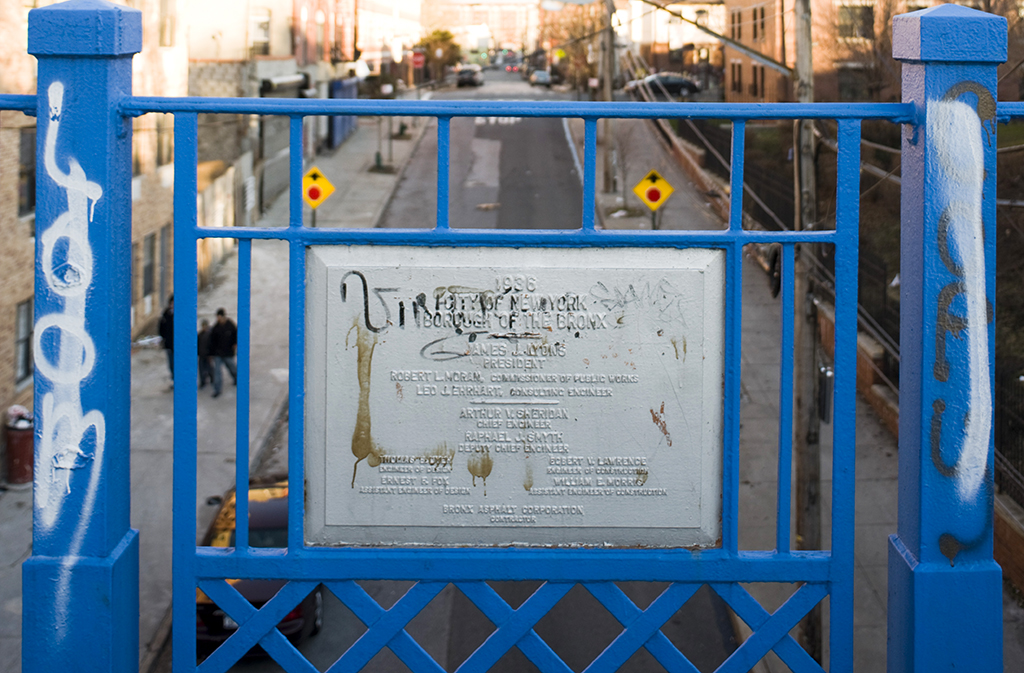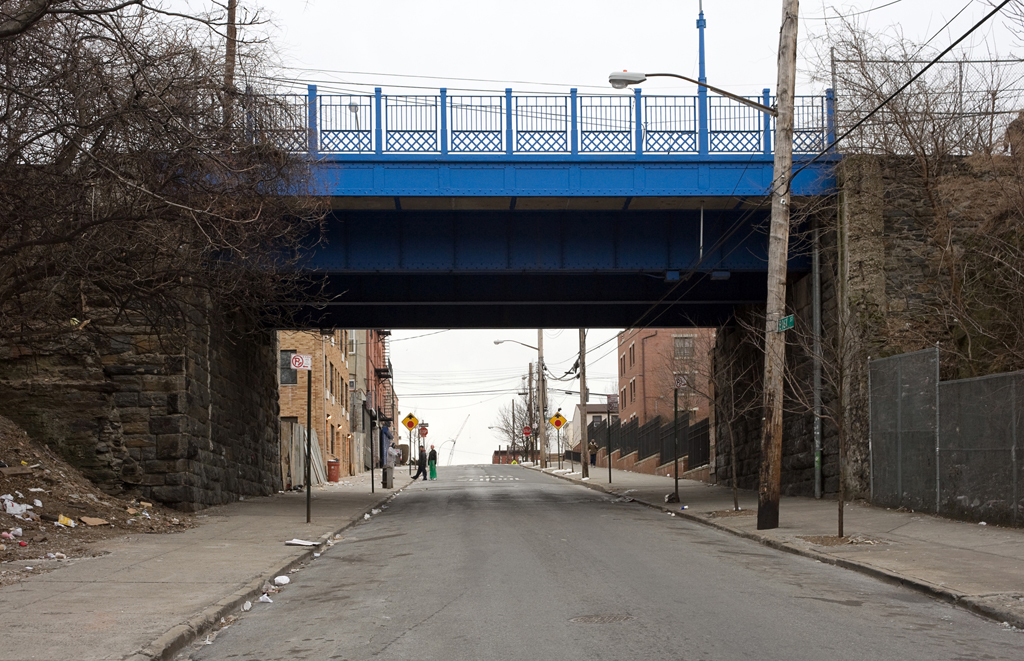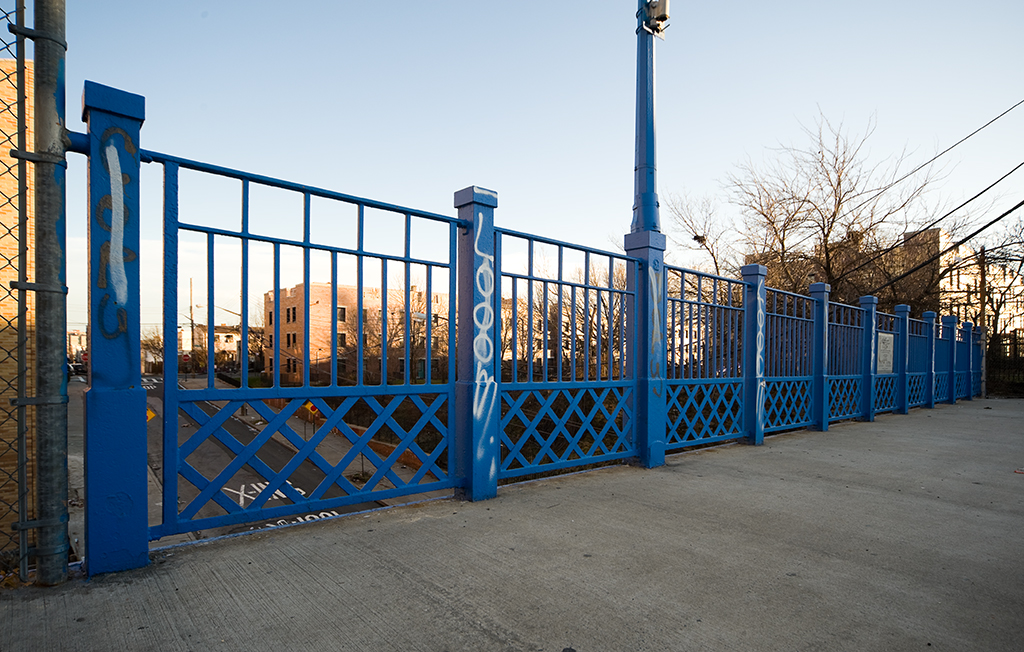
Location: Eagle Avenue over East 161st Street, Bronx, NY [satellite map]
Carries: 1 vehicular lane, 2 pedestrian sidewalks
Design: girder bridge
Date opened: 1936
Traveling south on Eagle Avenue in the Melrose section of the Bronx, instead of reaching an intersection at East 161st Street as a street map would lead you to believe, your line of sight on this narrow road suddenly opens up and you find yourself crossing a little-known bridge with a view of the imposing Beaux-Arts Bronx Borough Courthouse (built between 1905-1914, abandoned in 1978) to the west. That the Eagle Avenue Bridge is almost never marked on as being a bridge on maps is not a new development; maps contemporary to its construction do not note is as a bridge either, maintaining the idea that one could turn from Eagle Avenue onto East 161st Street. The need for a bridge becomes apparent though when taking the area’s geography into account. Eagle Avenue is located on what was once part of the Morris Manorlands, a tract of almost 1,920 acres formerly owned by Declaration of Independence signer Lewis Morris. This area of the Bronx is full of rocky hills necessitating steep streets, stepped walks, and unexpected bridges. Before the streets in the area were given standard number designations, East 161st Street had been known by several names, including Grove Hill and Cliff Street. The hill at East 160th Street and Eagle Avenue was known as Hupfel’s Hill, after the Hupfel Brewery, which started brewing beer in the area in 1864. Eagle Avenue was laid out in 1891 between 149th and 163d Streets, and the first bridge over East 161st Street was built then of steel, with stairs allowing pedestrians to travel between the upper and lower levels of the crossing.

The current Eagle Avenue Bridge is at least the second bridge at the site, and was opened in 1936. The stone abutments supporting the span appear to be leftovers from the earlier structure. It is a steel girder bridge painted a bright Federal Blue, one of the seven colors used to paint bridges by the Department of Transportation’s Division of Bridges, and is 53.8 feet long. It has been cleaned and repainted by the DOT twice in recent years, in 2003 and 2008. It was built under the authority of Bronx Borough President James Lyon and designed by Arthur V. Sheridan (1888-1952), Lyon’s chief engineer. Sheridan later went on to design highways during the reign of city planner Robert Moses, and is the namesake of the Bronx’s Sheridan Expressway.

– – – – – –
References
1974. Caro, Robert A. The Power Broker: Robert Moses and the fall of New York. New York: Knopf.
1988, July 24. Gray, Christopher. Streetscapes: Bronx Borough Courthouse; For an abandoned civic landmark, a second life? New York Times. Retrieved from: nytimes.com
1996. McNamara, John. History in Asphalt: The Origin of Bronx street and place names, the Bronx, New York City. Bronx, N.Y.: Bronx County Historical Society.
2003. New York City Department of Transportation Division of Bridges. 2003 Bridges and Tunnels Annual Condition Report. Retrieved from: nyc.gov
2005, January 23. Walsh, Kevin. Forgotten New York: The Hub. Retrieved from: forgotten-ny.com
2008. New York City Department of Transportation Division of Bridges. 2008 Bridges and Tunnels Annual Condition Report. Retrieved from: nyc.gov
2008, October 3. Beck, Graham T. The City Visible: Painting the town. The New York Times, p. CY4. Retrieved from: nytimes.com
EX NEW YORK BRONX COP BRON 441 EAST 142 ST 1943 EDID NOT REMENBER EAGLE AVE BRIDGE WILL VISIT IT NEXT TIME BACK IN NY WORK IN D.C . LIVE IN CONGERS NEW YORK RET 1983 BRONX TASK FORCE
I remember the Eagle Avenue Bridge because my parents bought a home on Eagle Avenue which was very close to the bridge. I attended P.S.10 in kindergarten and P.S. 140 from first grade on.
I walked across that bridge every day.
In honor of my Mother, I recently visited my birthplace Eagle Avenue Bronx, NY this past May which was literally right by the bridge. The building we lived in is no longer there, and the steps are gone as well but It was still a very emotional yet melancholy experience. Rest in peace Mom, I love you forever!
go just a bit farther back towards St. Anns Ave, while still facing that bridge, and you will see the scene of the part of the Fort Apache movie where Paul Newman breaks the headlights of the pimpmobile.
you can see the original bridge in the top left of this old 1898 photo of the Hupfel Brewery.
https://dlc.library.columbia.edu/catalog/cul:xgxd2547nb/details?initial_page=0
The taller building in the center of the photo is still rotting away at the location. see google satelite view.
Very cool, thank you for posting this!
I lived on Cauldwell Avenue off the corner of 161st Bridge. I moved out of the Bronx in 1962. I went to P.S. 10 on Eagle Avenue grammar school and walked frequently on the hill and used the stairs to go to school. What year did they remove the stairs and why? Do you have any photos of 161st Street hill from the 1950’s or 1960’s? The landscape in the above photos Are unrecognizable to me!
Hi Dori, I don’t know when the stairs were removed–there’s not very much information about this bridge and we were unable to find historical photos of it (nor did we know there used to be stairs). Thank you for sharing your memories of the area in the 50s and 60s!
A previous commenter found this image; the bridge is visible in the upper left but you can’t see much detail around it: https://dlc.library.columbia.edu/catalog/cul:xgxd2547nb/details?initial_page=0
Was there a sidewalk newsstand under the bridge? I remember in the early 1980s there were what appeared to be remnants in the concrete of some sort of structure on the sidewalk just west of the bridge. Maybe it was the landing of the stairs, but at the time I thought it was part of an old newsstand.
This photo from 612 East 161st Street from 1915 shows what appear to be the stairs from Eagle Ave.: http://dcmny.org/islandora/object/photosnycbeyond:47550 (The building is no longer there.) There are structural remains around the bridge today, though we’ve not been able to find a street-level photo from 161st Street, so it’s unclear if there was a newsstand in addition to stairs or if what you saw were the remains of the stairs.
Here’s an image from Eagle Ave. in 1917: http://dcmny.org/islandora/object/photosnycbeyond:32671